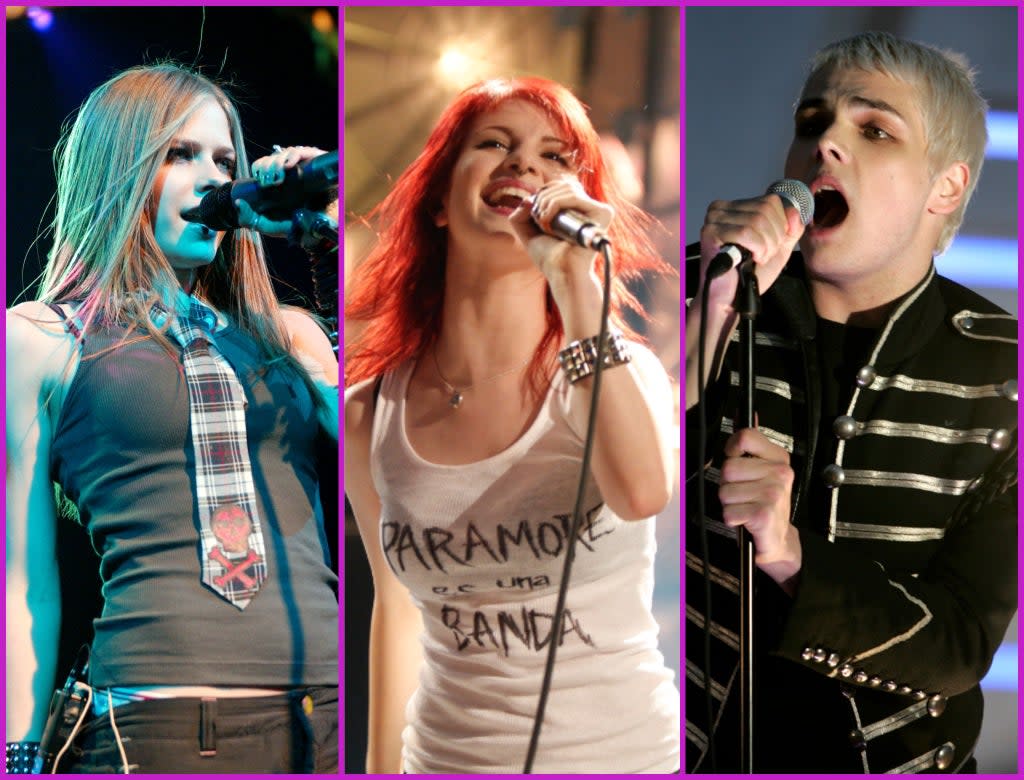Welcome to the Black Parade – why millennial emo fans need to embrace Gen Z

Break out the black eyeliner! The announcement of a major one-day music festival in Las Vegas, including some of the biggest emo and pop-punk acts of the Noughties, has been met with delight from millennial fans who grew up relating to angsty lyrics by acts such as My Chemical Romance, Paramore and Avril Lavigne. Their music was an analgesic for teens who felt like social outcasts. You could identify a fellow Fall Out Boy or Funeral For A Friend fan by the badges pinned all over their school bags. Teenage wrists were weighed down by black rubber bracelets and faded wristbands from Reading and Leeds, Download and Slam Dunk. Sales of skinny jeans, converse trainers, black hair dye and piercings went through the roof. Side-fringes were everywhere.
Yet news of the festival has prompted some fans to go on the defensive, even before tickets have gone on sale. “It’s called When We Were Young, I don’t wanna see none of you Gen Z motherf***ers,” one person tweeted. “Listen little Gen Zs, I let you have the Olivia Rodrigo tickets but you better not come for my When We Were Young tickets,” another warned. This comes after months of eye-rolling over viral videos of teenagers discovering “The Middle” by Jimmy Eat World, or making tutorials for how to dress emo. It’s an unsettling display of tribalism.
In recent years, certain fashions – and the music scenes they accompanied – have made a comeback. Gen Z (those born between 1997 and 2012) has been credited with reigniting an interest in Noughties trends as they discover artists such as Panic! At the Disco and Taking Back Sunday for the first time. Last year, one of the most popular songs on TikTok was “Misery Business” by Paramore, arguably due to its heavy influence on Gen Z pop-punk star Olivia Rodrigo’s 2021 single “Good 4 U”. And new acts such as Meet Me @ The Altar and The Tuts are helping to make the genre, formerly dominated by white musicians, a more inclusive place. In 2020, Meet Me @ The Altar signed to Fueled By Ramen, the label that launched the careers of bands including Jimmy Eat World, Paramore and Panic! At The Disco. “It’s so incredibly important to have representation as POC women in this scene, because when we constantly see only all straight white cis male bands on lineups and magazine covers, it inherently teaches us that we don’t belong,” Téa Campbell, Meet Me @ The Altar’s guitarist, told The Independent last year. “The scene belongs to everyone and it’s time that the stages reflect that.”
When it comes to music, generation wars are nothing new. Older fans resent younger age groups staking claims on the artists who spoke to them as misunderstood teenagers. Younger fans hate being spoken down to, told that their opinions matter less than those of the fans who were “there first”. I’ll never forget the patronising tone with which an older music critic, having shut me out of a conversation about The Beatles, turned to me and said: “So what are the young people listening to these days?” While streaming services and social media have levelled the playing field in many ways – younger generations have immeasurably better access to music than those before them – it also seems to have sparked a tug of war. Maybe snobs would rather they didn’t stumble on “Dreams” by Fleetwood Mac via a video of a random guy skateboarding and drinking cranberry juice. But isn’t it a good thing if that leads them to the rest of the band’s catalogue? Why shouldn’t they be allowed to lip-sync to the drama of “I Write Sins Not Tragedies”, or mosh along to Gerard Way’s howls on “I’m Not Okay (I Promise)”?
When We Were Young is a fantastic chance for Gen Z to actually see the bands they’ve been obsessing over online for the past few years. Often the most joyful gigs are the ones where you look around and see multiple generations in the same space, proving exactly how good music just goes on and on. Fellow millennials, be better than our parents! Don’t let the teenagers scare the s*** out of you.

 Yahoo News
Yahoo News 
